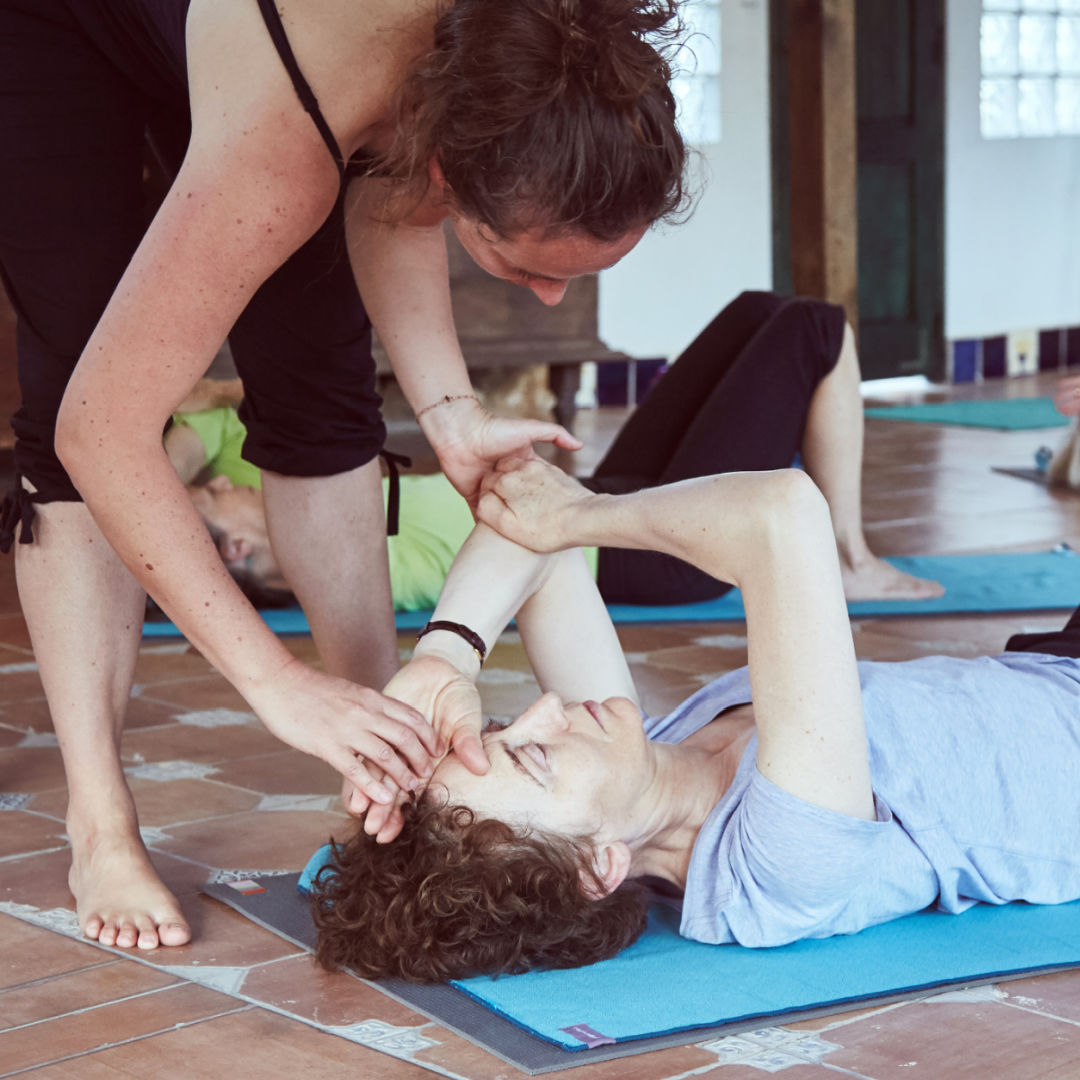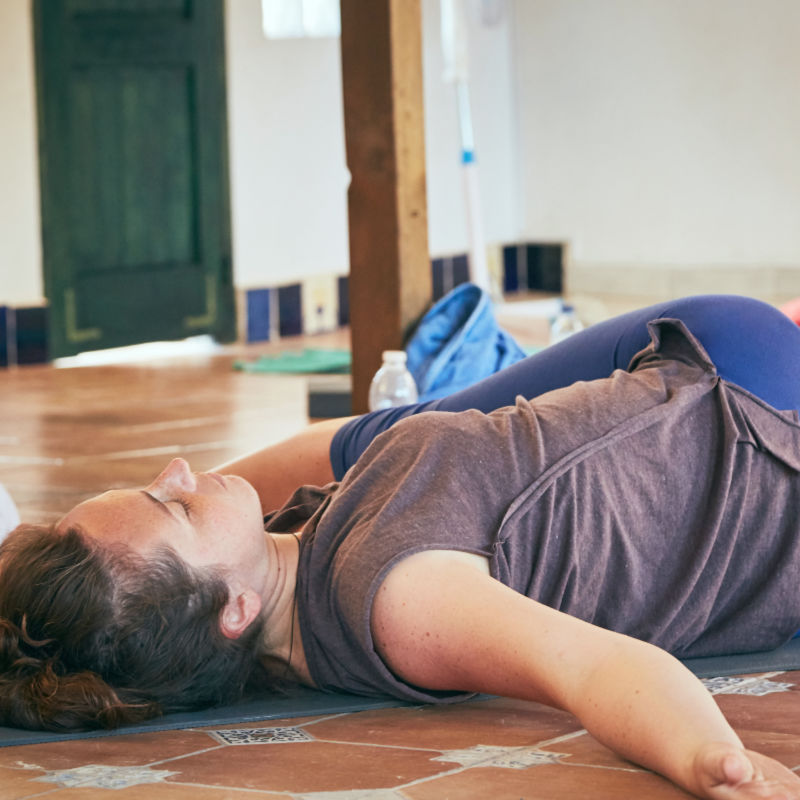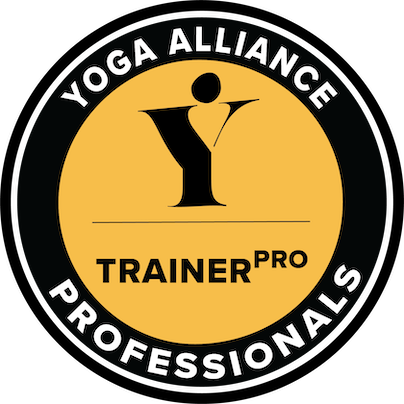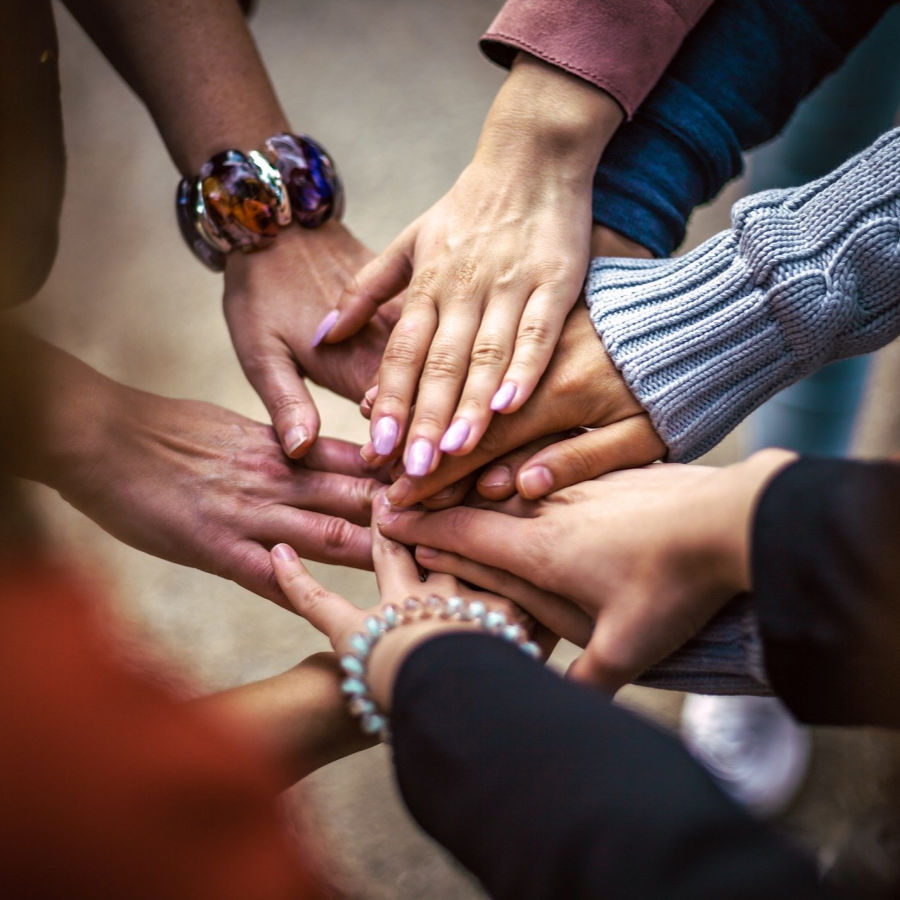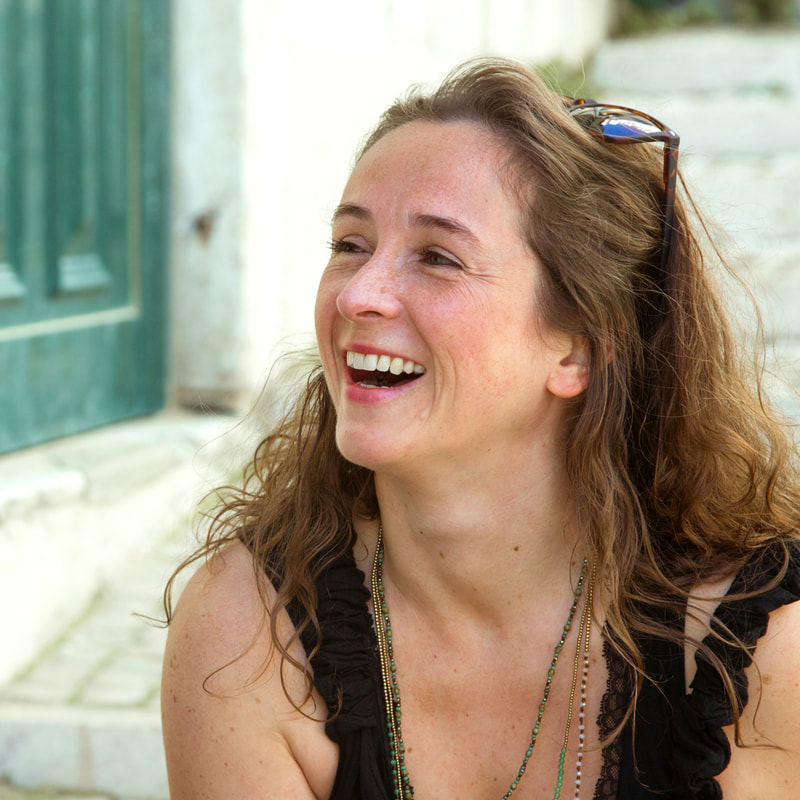The Language of the Body
A therapeutic and trauma-informed approach to teaching Yoga
60h continued training course for Yoga Teachers
Next cohort starts in 2025!
You love teaching yoga, but you don’t feel confident or equipped enough to work with people suffering from chronic conditions, pain or anxiety in your classes. However, one of the reasons you became a yoga teacher in the first place, is that you wanted to help people to improve their quality of life and your intention for your classes is for them to be fully inclusive and accessible. Maybe you even feel drawn to specialising your yoga classes one day.
In this 60h accredited training course you will gain an understanding, techniques and tools to help you support people during their individual healing process.
3 more spaces available. So I am offering a last-minute joiner discount of 15%!
60h continued training course for Yoga Teachers
Next cohort starts in 2025!
You love teaching yoga, but you don’t feel confident or equipped enough to work with people suffering from chronic conditions, pain or anxiety in your classes. However, one of the reasons you became a yoga teacher in the first place, is that you wanted to help people to improve their quality of life and your intention for your classes is for them to be fully inclusive and accessible. Maybe you even feel drawn to specialising your yoga classes one day.
In this 60h accredited training course you will gain an understanding, techniques and tools to help you support people during their individual healing process.
3 more spaces available. So I am offering a last-minute joiner discount of 15%!
Why this mattersWhen people suffer from chronic conditions, pain, stress, anxiety or depression, or they are recovering from a serious injury, or maybe going through treatment for something, they more and more often turn to body-mind practices, including Yoga, to help them find more ease and comfort, to manage the severity and frequency of flair-ups, and to speed up recovery. However, their condition probably means, that the ‘normal’ Yoga class is not appropriate for them and they end up feeling more overwhelmed.
A therapeutic and trauma-informed approach to teaching Yoga will create a safe space for people, where we can facilitate people’s individual process of healing or managing their condition. And this we know - healing can only ever take place in a safe place, an environment of less conflict. |
This is a 60h accredited training and will take place online.
We will meet on Zoom for 8 live modules (between 4h and 6h in length) spread over 4 weekends between March and April. There is always a Friday evening session, as well as a morning and afternoon session on both the Saturday and Sunday. You can find a detailed outline below. And in May will be another meeting for final assessments.
As well as a training course, this programme is a true immersion to deepen your understanding of human nature (including your own) and potentially change your own practice fundamentally. There will be homework, reading, practice, research, (self-)enquiry, and exploration.
We will meet on Zoom for 8 live modules (between 4h and 6h in length) spread over 4 weekends between March and April. There is always a Friday evening session, as well as a morning and afternoon session on both the Saturday and Sunday. You can find a detailed outline below. And in May will be another meeting for final assessments.
As well as a training course, this programme is a true immersion to deepen your understanding of human nature (including your own) and potentially change your own practice fundamentally. There will be homework, reading, practice, research, (self-)enquiry, and exploration.
Changing the storyYou have the opportunity to empower people with Yoga, which is a very important step in their healing process. You can help people change the narrative of the stories that dictate their lives, from a story of pain and problems, to a story of healing and balance.
This course brings together the teachings of:
|
This is how these practices changed my life: When I was 13, I developed quite severe scoliosis, which meant having to wear an orthopaedic corset and doing a lot of physio-therapy throughout my teenage years. This was probably the beginning of my interest and curiosity in the human body and movement. I was managing just fine in my 20’s with regular Pilates and dance, however, around when I turned 30, I started to have a lot of discomfort particularly on my right side, and I needed regular massages to ease the pain. Eventually I ended up seeing a cranial osteopath every single week for three months, which was getting very depressing. I was half-way through my Yoga Teacher Training back then, and luckily had experienced a few workshops on fascial release, had the odd encounter with non-dogmatic teachers, and somehow had the wisdom in my own body, that there was another way. I was about to start teaching Yoga, but nonetheless decided to turn my own personal practice up-side-down and to start again from square one. I took charge of my own wellbeing. Living in London at the time, it was a borderline miracle, that a Scaravelli inspired teacher was living literally around the corner from my house. The week I started having sessions with her, I never had to go back to the osteopath.
My body is now pain-free and my spine has become one of my greatest teachers over the years. But through my continued practice as well as deep study of Osteothai, I am also healing my emotional scars I carry from being stuck in a corset for three years, which I now understand was a quite traumatic experience and has left behind patterns in my body as well as the narrative of my stories.
The development of “The Language of the Body” is a very natural and direct conclusion of my own life story (as well as professional experience of course) and strongly believing that our bodies are designed to heal.
My body is now pain-free and my spine has become one of my greatest teachers over the years. But through my continued practice as well as deep study of Osteothai, I am also healing my emotional scars I carry from being stuck in a corset for three years, which I now understand was a quite traumatic experience and has left behind patterns in my body as well as the narrative of my stories.
The development of “The Language of the Body” is a very natural and direct conclusion of my own life story (as well as professional experience of course) and strongly believing that our bodies are designed to heal.
Our bodies are designed to heal
This is where the foundation lies to this approach to teaching Yoga (and practicing it).
The body has an incredible innate intelligence. It already holds all the information to being healthy. It’s like there is a blueprint to the body’s health. So the process of healing is therefore always about self-healing. As teachers and therapists we simply facilitate an environment of less conflict, in which someone feels safe enough to come home to their true Nature.
This requires a lot of work un-doing all of our habitual holding patterns, re-educating the body, re-wiring the nervous system. In a way it’s like learning a new language. In this case, the Language of the Body.
The body has an incredible innate intelligence. It already holds all the information to being healthy. It’s like there is a blueprint to the body’s health. So the process of healing is therefore always about self-healing. As teachers and therapists we simply facilitate an environment of less conflict, in which someone feels safe enough to come home to their true Nature.
This requires a lot of work un-doing all of our habitual holding patterns, re-educating the body, re-wiring the nervous system. In a way it’s like learning a new language. In this case, the Language of the Body.
The training course
This is an online course, with 8 live modules taking place on Zoom.
THE SCHEDULE
All times are London/Lisbon based. Most of Central Europe is +1h.
THE SCHEDULE
All times are London/Lisbon based. Most of Central Europe is +1h.
|
1/2/3/ March 2024
Friday: 18:30-20:30 Pre-Orientation Call and Welcome Saturday: 10:30-12:30 & 14:30-16:30 Module 1: The Autonomic Nervous System and Polyvagal Theory Sunday: 10:30-12:30 & 14:30-16:30 Module 2: Fascia and Body Memory 15/16/17 March 2024 Friday: 18:30-20:30 Saturday: 10:30-12:30 & 14:30-16:30 Module 3: Yielding / Tensegrity / Expansion & Retraction Sunday: 10:30-12:30 & 14:30-16:30 Module 4: Stillness and Listening, working from a Fulcrum |
5/6/7 April 2024
Friday: 18:30-20:30 Saturday: 10:30-12:30 & 14:30-16:30 Module 5: Trauma informed language and practices Sunday: 10:30-12:30 & 14:30-16:30 Module 6: Sensory Input and Chronic Pain 19/20/21 April 2024 Friday: 18:30-20:30 Saturday: 10:30-12:30 & 14:30-16:30 Module 7: The Breath and Resiliency Sunday: 10:30-12:30 & 14:30-16:30 Module 8: The diaphragmatic pressure system 18/19 May 2024 Final assessments |
|
In each module we will cover:
Each module will involve:
|
All course materials will be made available on a well-structured online delivery platform:
In addition, also part of the programme are:
|
Yoga Alliance Professionals
|
This is a 60h accredited continued training course. For the certificate, it is therefore required to not only complete the live modules, but all of the home-study as well. There will be a final evaluation consisting of:
|
Who is this course for
There are a few pre-requisites for joining this training:
You might particularly enjoy this course if:
However, if any of these points speak true for you, then this course is probably not the right fit for you, at least not right now:
- you have completed a 200h yoga teacher training (minimum)
- you take your continued education responsibility seriously and want to do further training
- you are open to a non-dogmatic approach to teaching yoga
- you have a solid self-practice
- you need to be prepared to also work on yourself
You might particularly enjoy this course if:
- you have experienced and enjoyed Scaravelli Inspired Yoga, Embodied Yoga, Somatic Movement, Feldenkrais or Qi Gong
- you love and practice regular self-care rituals
- you are increasingly coming to trust your gut and body signals when they say ‘no’ to situations
- you are a great listener
- your aim in life is to collect stories, so that whenever anyone asks you a question, you have a little anecdote to tell
- you just hate yoga teachers advertising their classes in their bikinis
- you are also a bit of a geek and can get quite excited by neuroscience, anatomy and research studies
- you love dancing and moving your body, albeit in the privacy of your living room
However, if any of these points speak true for you, then this course is probably not the right fit for you, at least not right now:
- you are not able or willing to invest 60h+ over 3 months for this training
- you are not able or willing to do 3h of homework and home practice per week. You will get the most out of this training, only if you do the work between the modules. I want you to walk away from this training, feeling that you have gained valuable tools and skills, that are relevant for YOUR work. This training is a commitment to yourself and your personal development. And please also bear in mind, that the hours between the modules form part of the total 60 hours, and are therefore required for your certificate at the end.
- you have become a yoga teacher because you think you can fix people
- you are currently dealing with your own deep trauma process. Whilst you need to also do some work on yourself during this programme, you should focus on your own therapy first for now. This training could be too overwhelming for you and not aid your own healing process at the moment.
- you are looking for a specialised training course focussing on conditions outside the scope of chronic conditions, pain, injuries, anxiety, depression and trauma. These are already a lot of conditions to work with, and there is only so much that can be covered in 60h with integrity.
Are you still reading this, and are not actually a yoga teacher? So you are interested in this topic, because maybe you work with people with these conditions but in a different capacity, or because you love diving deeper into your own practice. Get in touch with me, as there will be TWO guest seats available on this programme.
What previous trainees say about this course
I joined this course because I wanted to create a movement practice specifically for women with lipoedema. Despite having 7 years teaching experience I didn't feel that I had all the tools I needed. I had looked at other courses in trauma informed yoga and somatic experiencing but this was the only course I found that integrated all the elements I was looking for in a spacious and beautifully held container which allowed time and space for the integration of theory through practice. The course was a laboratory for me experiment with different practices and really refine and clarify my intention for my offering. Throughout the course, I have been able to critically reflect on my language choices and build awareness of how to use language more inclusively. By the end of the course, I felt confident to design and successfully deliver pilot course for women with lipoedema which integrates a range of movement practices and creates a brave space which empowers women to explore movement. Thank you for the amazing experience, this course is designed beautifully. Really appreciative of you guiding us in doing the same in creating our own course by the end of the 8 weeks and creating an inclusive learning environment despite the time difference. The Language of the Body is great for every teacher who is looking for a course on trauma-informed yoga with a therapeutic approach. I have learned valuable teaching skills and tools that I can apply to my work and to my own practice. The training is both non-dogmatic and creative and lets you explore your own personal way on how to apply the content to your teachings. I have created a tool box based on these principles that I am using on a daily basis and that I am also sharing with my students. A valuable course all in all with a great teaching platform and an interesting reading list that is still ongoing. Thank you for this experience. :) Great experience for any yoga teacher that seeks to go further in the understanding of and teaching a trauma-informed type of yoga. Very creative and diverse content, as well as a good balance between theory and practice. Highly recommended! I found the Language of the Body such a unique course. Even though I am already a yoga therapist, there were so many new ideas and approaches and it has given me some much needed inspiration! And Katrin is a very caring and supportive teacher. |
As an experienced yoga therapist, I found the Language of the Body Course with Katrin Heuser has given me a lot more techniques and postures to teach, as well as helping me to change the language I use when I'm teaching both 1:1 and group classes. This course has deeply changed and inspired my practice to evolve and embrace, safely and progressively, a more therapeutic and trauma informed approach in yoga. It is a much-needed approach to teaching yoga and has been of a great help, personally, to navigate current times. Learning to create safe and inclusive spaces and deepening the understanding of the body in all its dimensions have been only a few of the many valuable teachings of this course, which always included plenty of tools and teaching skills to put every principle learnt into practice. I surely and highly recommend this course and I am looking forward to studying and practicing further what I have learnt over these 6 months with Katrin. I learned so many new poses and techniques for releasing tension/ trauma in the body, soothing the nervous system and relaxing. Throughout the course I taught to a group of friends online, so that I could practice the teaching and it also helped me to remember what I was learning. Katrin is a great teacher - materials were excellent, and the web portal she used is so straightforward to access, and navigate. She encouraged lots of feedback and interaction, so while it was not an in person training it was something to look forward to each month. I highly recommend this. |
What you will walk away with by the end of the course
|
Relevance
My biggest wish is that by the end of this training you have gained tools and skills that you can actually put to work, that are helpful in the context of what you do. I want you to have the confidence to bring the focus to your work that you feel most passionate about. |
Personal growth
As Yoga teachers we need to also deal with our own stories, and continuously work on building our own resilience. Study, practice, sharing, connecting with community, deepening our understanding - all so important on this incredible journey. |
Improving other people's lives
When we became Yoga teachers, we also committed ourselves to always keep learning, so we could continue getting better and better at serving our community. With Yoga we have so much potential to support people on their challenging paths. |
Some examples of what previous trainees have developed from this course
|
One participant developed a 4-week course for women living with lipoedema. Many women with lipoedema have experienced exclusion in conventional Yoga classes compounding years of accumulated trauma of fat shaming. The course aims to create a brave space for women to explore movement in a supportive community and to build resilience. This course offers movement based practices, rituals and Yoga Nidra.
|
Somebody else created a 6-week movement and Yoga course she wanted to propose to a local housing facility for refugees. We discussed how to make contact with the organisation initially, how to develop a proposal from there, and all the logistical things (such as provision of Yoga mats, the possible need for a translator etc) to consider.
|
Another trainee designed a 6-week course, that bridges the Yoga philosophy of the Gunas and healing our modern lifestyle disconnect from our natural rhythms. This course facilitates a complete and integrative process, with homework, journalling, resourcing tools, and a retreat option, fostering sustainability of self-practice.
|
How people experience this kind of Yoga
In my first retreat I got to know Katrin and her teaching methods. She has a profound and deep understanding on how to learn to listen to the body's signals and to find ease in unease. In a way it really shifted my personal view on Yoga and what it means for a healthy life. One of the unexpected upsides of the pandemic is the chance to have a regular Yoga practice, amongst other things, with Katrin. As I live in the UK and she is in Portugal, previously I only had the pleasure to participate in her workshops once or twice a year. Now I can have lessons with her every week which is amazing! I discovered that Katrin’s yoga style really suits my needs as my battered body and mind try to navigate the new realities of living during the pandemic. Her classes are gentle but I wouldn’t call them easy. There is a profound concentration on natural body mechanics, breathing, creating comfort for the body amongst many other things. It’s all about ease and becoming friends with your body once again. Quite a complex task, but Katrin is very good at navigating you through. She has all the qualities I value in a teacher - caring and dedicated to her students, paying attention to their individual needs, being serious and fun and giving clear instructions and explanations. I feel more relaxed and at peace with my body and mind after her classes. The immersion workshops are brilliant as well, you can delve a bit deeper into the practice. I wholeheartedly recommend her classes and workshops to everyone, but particularly to those who, like me, are feeling a bit fragile at the moment. You’ll find all the help and support that you need! And from a technical point of view, since we have to communicate and do yoga in Zoomland now, Katrin’s classes are top quality. |
Discovering Katrin’s Yoga teaching with her mix of Scaravelli inspired Yoga and Eastern bodywork traditions was life-changing 10 years ago. I’ve been delighted recently to work with her again online. Katrin’s approach is deceptively simple yet the benefits are profound. The careful attentive approach and the kindness of the Yoga make it suitable for people of any age, and I continue to learn from Katrin's subtle insights into the body/mind connection. I’ve particularly benefited from her workshop focusing on the breath. I try to use her breathing exercises now daily- great to help feel grounded in these challenging times! After five years of varied Yoga experiences, I initially met Katrin for a 5-day Thai Yoga Massage course in Lisbon. During this time I really got in touch with my own body and its own specific language. I started to listen, translate, feel and touch in a different way. These were great tools to solve my long-lasting problems with my own personal yoga practice. Later, Katrin introduced me to Scaravelli inspired Yoga. My body responded in a way it never had before in my practice. I found open spaces and a new kind of lightness. My practice turned into something very different without pulling and stretching. I'm very happy with this change. Now I work with Katrin on the breath and it's amazing how my breathing capacity grows through such soft practices, instead of the usual teachings I was used to before. Katrin is an amazing person and an authentic teacher with a universe of knowledge always willing to share. I'm really thankful to know her. |
We will empower each other
|
This training course is designed for you to learn a huge amount, to help you progress in your career, and to improve your skills. And of course it is so much more. It requires a commitment from you. Not only with regards to time and money, but it will ask a lot of you personally and energetically as well. You will need to make some real space for this training. And if you do, it will be an incredible opportunity for deep self-enquiry and your personal healing to accelerate. Learning how to empower others, will empower you!
The pandemic has brought up a lot of things for many people. So did the continued conflicts in the world and the uncertainty of what our future might bring. More than ever, we need to awaken our resilience and take courageous decisions. And more than ever, therapists, movement practitioners, Yoga teachers like you, are needed to step up. There will only be 12 places (plus two guest seats) available on this course. This will guarantee you my undivided attention. I will be able to get to know you and support you during the programme and your personal journey. |
Equity pricing
This training course is offered with a scaled pricing structure with three options rather than one fixed price. The intention is to allow more people to access the course, supported by the community and those who have access to more funds. Please choose the option that feels appropriate to you and your circumstances. You will not be asked to justify your choice.
3 more spaces available. So I am offering a last-minute joiner discount of 15%!
Use coupon code LOTB15 during check-out.
Use coupon code LOTB15 during check-out.
|
TIER 1 REBALANCING For those with good financial resources and wish to support the participation of others to help rebalance systemic inequity. €745 |
TIER 2 FAIR For those with medium incomes and who have sufficient financial resources and can pay the fair value for the training. €645 |
TIER 3 SUPPORTED For those who currently have limited financial resources and can benefit from a place supplemented by the community. €545 |
Any concerns you might have
1) You can’t make all of the live modules
> There will be recordings available of all the sessions, and you can watch them on replay. Ideally, you join at least 80% of the webinars live in person, so if you have to miss a small chunk, it’s not a problem. And, I also know that it suits some people much better to learn in their own time, and so this is not a hard and fast rule. If doing the majority of the modules on replay means it's more accessible for you, then that's good for me, too.
2) You feel Zoomed out
> I hear you. I tried to schedule the modules with big enough breaks, so we really have time to eat, move, and get away from the screen. Any session longer than 2h will have a little comfort break half-way.
3) Is it really possible to learn this stuff online?
> All of the modules have been created from well tested workshops and seminars, and have gone through several rounds of improvements. I teach online a lot, and have planned lots of additional time into the modules, so the nature of working on Zoom can be accommodated. And the course will be limited to 12 people (plus 2 guests), which means we can all comfortably see each other and connect and communicate.
4) You have students suffering from any of the conditions already and want to help them straight away
> After each module, you are highly encouraged to apply what you have learnt. This is the best way to really understand it and to embody the principles. The more you share this with your students, the more you will have to share and contribute in the upcoming modules and the more it will all make sense.
Is there something else, I haven’t thought of? Please contact me.
> There will be recordings available of all the sessions, and you can watch them on replay. Ideally, you join at least 80% of the webinars live in person, so if you have to miss a small chunk, it’s not a problem. And, I also know that it suits some people much better to learn in their own time, and so this is not a hard and fast rule. If doing the majority of the modules on replay means it's more accessible for you, then that's good for me, too.
2) You feel Zoomed out
> I hear you. I tried to schedule the modules with big enough breaks, so we really have time to eat, move, and get away from the screen. Any session longer than 2h will have a little comfort break half-way.
3) Is it really possible to learn this stuff online?
> All of the modules have been created from well tested workshops and seminars, and have gone through several rounds of improvements. I teach online a lot, and have planned lots of additional time into the modules, so the nature of working on Zoom can be accommodated. And the course will be limited to 12 people (plus 2 guests), which means we can all comfortably see each other and connect and communicate.
4) You have students suffering from any of the conditions already and want to help them straight away
> After each module, you are highly encouraged to apply what you have learnt. This is the best way to really understand it and to embody the principles. The more you share this with your students, the more you will have to share and contribute in the upcoming modules and the more it will all make sense.
Is there something else, I haven’t thought of? Please contact me.
Get to know me and about the programmeThere will be a few free orientation calls you are invited to.
This will be an opportunity to ask me any questions you might have, to understand more what to expect from the course, how much of a commitment it will be, and also to get to know me a little more. I will give an overview of the modules and also show you the online platform, where all the materials will live and where you can connect with everyone else. Friday 26th January, 13h-14h Monday 19th February, 13h-14h Introductory events & workshopsIn addition, between now and the start of the course, I am making a whole series of workshop recordings available for free, so you can get a real taste of what I and my approach to teaching is about.
> Take a look at the full list Or join me live, either in person at the Little Yoga Space or online via Zoom, for one of these workshops on a PAY WHAT YOU CAN basis. Saturday 20th January: The Story of the Pelvic Floor Sunday 11th February: Managing Chronic Pain in Yoga |
Do you have any questions? |
Register nowREGISTRATION CURRENTLY CLOSED!
TIER 1: REBALANCING
For those with good financial resources and wish to support the participation of others to help rebalance systemic inequity. TIER 2: FAIR
For those with medium incomes and who have sufficient financial resources and can pay the fair value for the training. TIER 3: SUPPORTED
For those who currently have limited financial resources and can benefit from a place supplemented by the community. |
Booking termsIn order to guarantee your place on this training, you need to make a minimum payment of at least one instalment.
If you choose to pay in instalments, the first one is due on registration, and the remaining two will be charged in one-month intervals from the date of your booking. All payments are non-refundable and non transferrable. Please make sure you are absolutely certain you want to make this commitment. Only in the case that I have to cancel the course for some reason, you will of course receive your money back or you will be offered a place on an alternative training. Please ensure you have a working computer and internet connection to join this training. |
Thank you for reading this long page
If you are really interested in this approach to teaching Yoga, but maybe it’s not quite the right time for a 60h training course for you, you might want to take a look at my general event schedule, as I often run shorter workshops around the same topics.
But if you have gotten all the way to the end of this page, and you notice this buzzy feeling in your gut, your intuition is telling you, this is the direction you want to take your teaching, and this is how you want to support people with your work, then I will love it if you join.
But if you have gotten all the way to the end of this page, and you notice this buzzy feeling in your gut, your intuition is telling you, this is the direction you want to take your teaching, and this is how you want to support people with your work, then I will love it if you join.
More about me
|
My whole life, I have been interested in the body and movement. After many years of dance, my Scoliosis lead me to Pilates and finally to Yoga and Thai Massage, which then became my path in life.
For me, my work is about the never-ending exploration of the body and mind, and a way of discovering the beauty of life. As we bring the awareness to what is happening inside and where we are in the present moment, the body is encouraged to release where it is holding. Then we can embark on a journey of restoration and transformation. I hold a 500h Level 4 NVQ Yoga Teaching qualification, trained in Manual Lymph Drainage and have studied extensively in Thai Yoga Massage and Osteothai, including a Master Osteothai qualification, over the past years. Through my work as a bodyworker comes also my understanding of trauma, chronic conditions and pain, as well as the influence of working with fascia, the craniosacral system, structural support and regulation of the nervous system. I used to run a Yoga Festival in London and launched an online anti-stress breathing programme. Since 2015 I live in Lisbon and run Little Yoga Space, where I teach and give Osteothai treatments, and I am the director of Hadadi, offering foundation and advanced training courses in Thai Massage and Yoga worldwide. |
